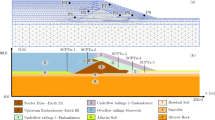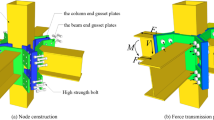Abstract
In this paper, a pseudo-static analysis has been presented to investigate the stability of soil nailed vertical/nearly vertical excavations. The failure surface is assumed as the arc of log-spiral passing through the toe of the excavation and intersecting the ground at right angle. The horizontal and vertical seismic forces are taken in terms of horizontal and vertical seismic coefficients. The internal failure mode of the nailed cut is considered either by pull-out or rupture or excessive bending whichever is critical. Expression for the factor of safety is derived using moment equilibrium method. Results have been arranged in tabular form considering ranges of the design parameters usually occur in practice. A typical table for the design of nailed excavation with driven nails is presented in the paper. Analytical results have been compared with the findings of model tests and reasonably good agreement has been observed.










Similar content being viewed by others
Abbreviations
- A s :
-
Area of nail = π/4 d 2
- c :
-
Cohesion acting along the surface of sliding wedge bd
- C′:
-
Is a constant and considered as C′ = 4 for the plastic analysis (Jewell and Pedley 1990)
- d :
-
Diameter of the driven nail
- f*:
-
Apparent coefficient of friction between nail and soil. It is obtained from pull out tests
- f y :
-
Yield strength of steel nail
- i :
-
Number of nail, It varies from i = 1 to i = N
- K a :
-
\( \frac{1 - \sin \,\phi }{1 + \sin \,\phi } \)
- le i :
-
Length of the ith nail behind the failure wedge
- l si :
-
Shear width = \( \sqrt {\frac{{8M_{\text{p}} }}{{\sigma_{\text{b}} }} \times \frac{1}{d} \times \left( {1 - \frac{{T_{i} }}{{T_{\text{P}} }}} \right)} \)
- M 1 :
-
Moment of force W 1 along the center of log-spiral i.e., point ‘o’
- M 2 :
-
Moment of W 2 along the point ‘o’
- M 3 :
-
Moment of W 3 along the point ‘o’
- M 4 :
-
Moment of W 4 along the point ‘o’
- M 5 :
-
Moment of W 1αh along the point ‘o’
- M 6 :
-
Moment of W 2αh along the point ‘o’
- M 7 :
-
Moment of W 3αh along the point ‘o’
- M 8 :
-
Moment of W 4αh along the point ‘o’
- M QV :
-
Moment of Q (1 ± αv) about the point ‘o’
- M QH :
-
Moment of Q αh about the point ‘o’
- M C :
-
Moment of cohesion force c about the point ‘o’
- M T :
-
Moment of nail axial force T i of the ith nail about the point ‘o’
- M Tc :
-
Moment of the mobilised shear force Tc i acting normal to the axis of nail
- M P :
-
Fully plastic bending moment of nail varying with shape of nail
- N :
-
Total number of nails in a single column of nails
- P i :
-
Perimeter of the ith nail (i.e., π d)
- q :
-
Applied surcharge intensity on the ground surface
- Tc i :
-
Mobilised shear in the ith nail which acts normal to the axis of nail at its intersection with slip surface, Jewell and Pedley (1990)
- T p :
-
Fully plastic axial force = f y × A s
- W 1 :
-
Weight of the soil wedge obd
- W 2 :
-
Weight of the soil wedge oed
- W 3 :
-
Weight of the soil wedge eab
- W 4 :
-
Weight of the soil wedge aba′
- \( \sigma_{{n_{i} }} \) :
-
Normal stress at the mid depth of ith nail in the length le i
- \( \sigma_{{n_{i} }} \) :
-
\( \frac{{\sigma_{y} \,\cos^{2} \theta - \sigma_{x} \,\sin^{2} \theta }}{{\left[ {\cos 2\theta \, + \,\sin 2\theta \,\tan \delta } \right]}} \)
- σy :
-
\( \left[ {\gamma (i - 0.5)\,S_{{{\upnu}}} + q} \right] \)
- σb :
-
Soil bearing pressure
- σv :
-
\( \gamma (i - 0.5)S_{{{\upnu}}} \)
- ω:
-
Log spiral angle
References
Chen WF (1975) Limit analysis and soil plasticity, Development in Geotechnical Engineering, vol 7, Elsevier Scientific Publishing Company
Gässler G, Gudehus G (1981) Soil nailing—some aspects of new technique. In: Proceeding of Xth ICSMFE, Stockholm, vol 3, pp 665–670
Gässler G, Gudehus G (1983) Soil nailing statistical design. In: Proceeding of VIIIth ECSMFE, Helsinki, vol 2, pp 491–494
Gosavi M (2006) Behaviour of nailed open cuts, Ph.D. Thesis, Indian Institute of Technology, Roorkee, India
Gosavi M, Saran S, Mittal S (2006) Software development for design of nailed open cuts, Souvenir of Indo-Australian Conference on Information Technology in Civil Engineering, IIT, Roorkee, India, pp 101–106
Gupta RP (2003) A study on soil nailing with respect to open excavations and slopes, M.Tech Thesis, Indian Institute of Technology, Roorkee
Jewell RA (1989) Theory of reinforce wall: revised design charts for steep reinforce slopes. In: Proceedings of the Conference on Reinforced Embankments, Theory and Practice in the British Isles, Cambridge University, pp 1–30
Jewell RA, Pedley MJ (1990) Soil nailing design: the role of bending stiffness, Ground Engineering, 30–36
Juran I, Elias V (1992) Ground anchors and soil nails in retaining structures In: Foundation Engineering Handbook, 2nd edn. Van Nostrand Company, pp 868–905
Juran I, Baudrand G, Khalid F, Elias V (1988) Kinematical limit analysis approach for the design of nailed soil retaining structures. In: International Geotechnical Symposium on Theory and Practice of Earth Reinforcement, Fukuoka, Japan, Balkema, pp 301–305
Juran I, Baudrand G, Khalid F, Elias V (1990) Kinematic limit analysis for design of soil nailed structures. J Geotech Eng 116(1):54–72. doi:10.1061/(ASCE)0733-9410(1990)116:1(54)
Mizuno E, Chen WF (1984) Plasticity models for seismic analysis of slopes, Int J Soil Dynamics and Earthquake Engg, 2–7
Patra CR, Basudhar PK (2001) Nailed soil structure: an overview. Indian Geotech J 31(4):322–362
Plumelle C, Schlosser C (1990) A French National Research Project on soil nailing: Clouterre, performance of reinforced soil structures. In: Proceedings of International Reinforced Soil Conference, Glassgow, pp 219–223
Raju GVR (1996) Behaviour of nailed soil retaining structures, Ph.D. Thesis, Nanyang Technological University, Singapore
Sabhahit N, Madhav MR, Basudhar PK (1996) Seismic analysis of nailed soil slopes—a pseudo-dynamic approach, Earth Reinforcement, Balkema, pp 821–824
Saha S, Murthy BR, Vatsala AS (2002) Soil nailed walls under dynamic loads, 12th Symposium on Earthquake Engineering, Indian Institute of Technology, Roorkee, pp 434–441
Saran S, Mittal S, Gosavi M (2005) Pseudo static analysis of nailed vertical excavations in sands. Indian Geotech J 35(4):401–417
Schlosser F (1982) Behaviour and design of soil nailing. In: Symposium on Recent Developments in Ground Improvement techniques, Bangkok, pp 399–413
Shen CK, Bang S, Romstad KM, Kulchin L, Denatale JS (1981) Field measurements of an earth support system. ASCE J Getotechnical Eng 107(GT12):1625–1642
Acknowledgments
Authors wish to thank Council of Scientific and Industrial Research (CSIR), New Delhi, India, for providing financial support for undertaking this research work.
Author information
Authors and Affiliations
Corresponding author
Rights and permissions
About this article
Cite this article
Meenal, G., Saran, S. & Mittal, S. Pseudo-Static Analysis of Soil Nailed Excavations. Geotech Geol Eng 27, 571–583 (2009). https://doi.org/10.1007/s10706-009-9258-z
Received:
Accepted:
Published:
Issue Date:
DOI: https://doi.org/10.1007/s10706-009-9258-z




